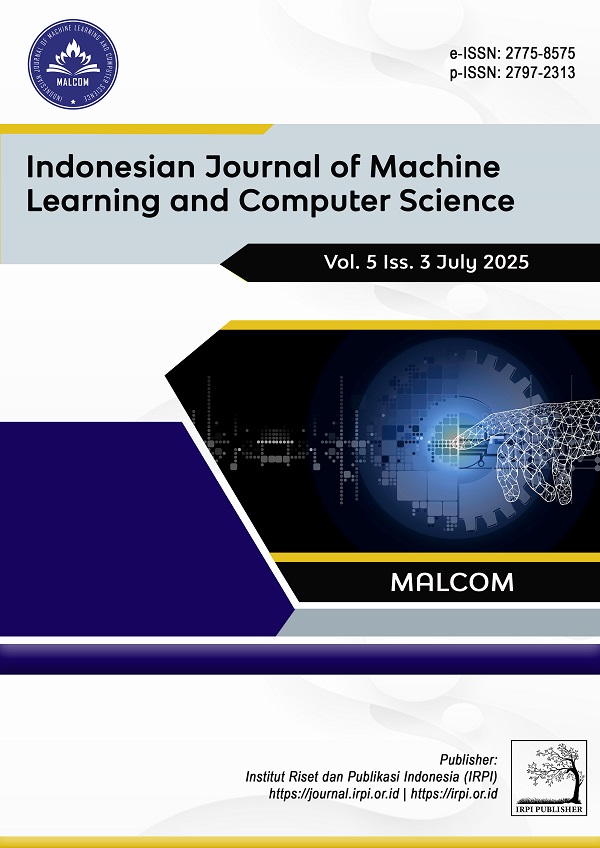Optimization of Customer Segmentation in the Retail Industry Using the K-Medoid Algorithm
DOI:
https://doi.org/10.57152/malcom.v5i3.1977Keywords:
Customer Segmentation, K-Medoid, Optimization, Retail Industry, Silhouette ScoreAbstract
The retail industry faces significant challenges in understanding increasingly complex customer behavior due to massive data growth. One major obstacle is suboptimal customer segmentation, leading to ineffective marketing strategies. This study aims to optimize customer segmentation by implementing the K-Medoid algorithm, which excels in handling outliers and producing more stable clusters compared to K-Means. The dataset consists of over 10,000 customer transactions from a major retail company in Indonesia. The research process includes data collection and preprocessing, K-Medoid algorithm implementation, and performance evaluation using the silhouette score. The results indicate that the K-Medoid algorithm achieves more accurate customer segmentation, with a silhouette score of 0.39. The generated clusters exhibit greater homogeneity, enabling companies to design more targeted marketing strategies, such as specific discount offers and tailored loyalty programs. Based on these findings, the K-Medoid algorithm is recommended to enhance customer management effectiveness in the retail industry. This study contributes to selecting a more suitable algorithm for customer segmentation in the era of big data and opens opportunities for further exploration of hybrid algorithms and additional evaluation metrics.
Downloads
References
S. Ghaida Muthmainah and A. Id Hadiana, “Comparative Analysis of K-Means and K-Medoids Clustering in Retail Store Product Grouping,” International Journal of Quantitative Research and Modeling, vol. 5, no. 3, pp. 280–294, 2024.
M. Galih Pradana, R. Dwi Amalia, and K. W. Gusti, “Optimalisasi Segmentasi Pelanggan Menggunakan Hierarchical Clustering,” Jurnal Teknologi Informasi, vol. 7, no. 2, 2023.
T. A. Pertiwi, M. Afdal, and R. Novita, “Penerapan Algoritma K-Medoids dan FP-Growth dalam Penentuan Pola Kombinasi Produk Berdasarkan Hasil Segmentasi Pelanggan,” Technology and Science (BITS), vol. 6, no. 2, 2024, doi: 10.47065/bits.v6i2.5268.
J. Hutagalung, M. Syahril, and S. Sobirin, “Implementation of K-Medoids Clustering Method for Indihome Service Package Market Segmentation,” Journal of Computer Networks, Architecture and High Performance Computing, vol. 4, no. 2, pp. 137–147, Jul. 2022, doi: 10.47709/cnahpc.v4i2.1458.
A. A. D. Sulistyawati and M. Sadikin, “Penerapan Algoritma K-Medoids Untuk Menentukan Segmentasi Pelanggan,” SISTEMASI, vol. 10, no. 3, p. 516, Sep. 2021, doi: 10.32520/stmsi.v10i3.1332.
T. L. Afandi, B. Warsito, and R. Santoso, “Implementasi K-Medoids Dan Model Weighted-Length Recency Frequency Monetary (W-Lrfm) Untuk Segmentasi Pelanggan Dilengkapi Gui R,” Jurnal Gaussian, vol. 11, no. 3, pp. 429–438, Jan. 2023, doi: 10.14710/j.gauss.11.3.429-438.
R. Azhar, U. Mahdiyah, D. Swanjaya, U. Nusantara, and P. Kediri, “Prosiding SEMNAS INOTEK (Seminar Nasional Inovasi Teknologi) Analisis Segmentasi Pelanggan Dengan Metode K-Medoids dan Simple Additive Weighting (SAW) Untuk Menentukan Strategi Pemasaran,” Online, 2024.
N. Mirantika, T. S. Syamfithriani, and R. Trisudarmo, “Implementasi Algoritma K-Medoids Clustering Untuk Menentukan Segmentasi Pelanggan,” vol. 17, pp. 2614–5405, doi: 10.25134/nuansa.
Z. Wu, L. Jin, J. Zhao, L. Jing, and L. Chen, “Research on Segmenting E-Commerce Customer through an Improved K-Medoids Clustering Algorithm,” Comput Intell Neurosci, vol. 2022, 2022, doi: 10.1155/2022/9930613.
A. Madani, A. Rahmah, F. Nurunnisa, and A. Elia, “SENTIMAS: Seminar Nasional Penelitian dan Pengabdian Masyarakat Customer Segmentation at BC HNI 2 Pekanbaru by Applying the K-Medoids Algorithm and Recency, Frequency, Monetary (RFM) Model Segmentasi Pelanggan pada BC HNI 2 Pekanbaru dengan Menerapkan Algoritma K-Medoids dan Model Recency, Frequency, Monetery (RFM).” [Online]. Available: https://journal.irpi.or.id/index.php/sentimas
P. A. Windjaya, B. Siregar, and K. Kunci, “(RFMTS) Menggunakan Algoritma K-Medoids Clustering,” Multidisciplinary Scientific Journal, vol. 2.
S. Ika Murpratiwi, I. Gusti Agung Indrawan, and A. Aranta, “Analisis Pemilihan Cluster Optimal Dalam Segmentasi Pelanggan Toko Retail,” Jurnal Pendidikan Teknologi dan Kejuruan, vol. 18, no. 2, 2021.
R. Siagian, P. Sirait, and A. Halim, “SISTEMASI: Jurnal Sistem Informasi Penerapan Algoritma K-Means dan K-Medoids untuk Segmentasi Pelanggan pada Data Transaksi E-Commerce The Implementation of K-Means and K-Medoids Algorithm for Customer Segmentation on E-commerce Data Transactions.” [Online]. Available: http://sistemasi.ftik.unisi.ac.id
I. S. Afari, “K-Medoids Customer Segmentation Algorithm by Utilizing Customer Relationship Management,” Journal of Computer Scine and Information Technology, pp. 89–93, Apr. 2023, doi: 10.35134/jcsitech.v9i2.69.
D. Ispandi, “Membangun Sistem Informasi Manajemen Laboratorium Komputer (SILABKOM) STMIK-AMIK Riau.”
R. Rahmaddeni, M. K. Anam, Y. Irawan, S. Susanti, and M. Jamaris, “Comparison of Support Vector Machine and XGBSVM in Analyzing Public Opinion on Covid-19 Vaccination,” ILKOM Jurnal Ilmiah, vol. 14, no. 1, pp. 32–38, Apr. 2022, doi: 10.33096/ilkom.v14i1.1090.32-38.
T. A. Pertiwi, M. Afdal, and R. Novita, “Penerapan Algoritma K-Medoids dan FP-Growth dalam Penentuan Pola Kombinasi Produk Berdasarkan Hasil Segmentasi Pelanggan,” Technology and Science (BITS), vol. 6, no. 2, 2024, doi: 10.47065/bits.v6i2.5268.
E. Hermika and S. Zuhri Harahap, “Application Of Data Mining In Selecting Superior Products Using The K-Means And K-Medoids Algorithm Methods”.
Y. Diana et al., “Analisa Penjualan Menggunakan Algoritma K-Medoids Untuk Mengoptimalkan Penjualan Barang,” JOISIE Journal Of Information System And Informatics Engineering, vol. 7, no. 1, pp. 97–103, 2023.
S. Ika Murpratiwi, I. Gusti Agung Indrawan, and A. Aranta, “Analisis Pemilihan Cluster Optimal Dalam Segmentasi Pelanggan Toko Retail,” Jurnal Pendidikan Teknologi dan Kejuruan, vol. 18, no. 2, 2021.
Downloads
Published
How to Cite
Issue
Section
License
Copyright (c) 2025 Endy Wulan Agustin, Kurnia Uthami, Arvan Izzatul Ulfa, Lusiana Efrizoni, Rahmaddeni

This work is licensed under a Creative Commons Attribution-ShareAlike 4.0 International License.
Copyright © by Author; Published by Institut Riset dan Publikasi Indonesia (IRPI)
This Indonesian Journal of Machine Learning and Computer Science is licensed under a Creative Commons Attribution-ShareAlike 4.0 International License.




















